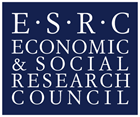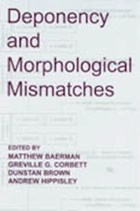Extended deponency: The right morphology in the wrong place
Formal analyses of deponency
This page contains links to Network Morphology accounts of five languages, illustrating some key points in the morphological typology of deponent paradigms. Network Morphology is a declarative framework that situates morphological facts in a network of information sharing nodes, thereby capturing the generalisations that can be made about morphology, while at the same time characterising exceptionality. Network Morphology theories are expressed in DATR, a unification based lexical knowledge representation language designed by Evans and Gazdar to support default and exceptional behaviour (Evans and Gazdar 1996). It is computationally implementable, and a variety of interpreters exist for DATR theories including that in the recently developed winddatr application (Evans 2006). For the Network Morphology framework, see Corbett and Fraser (1993); Evans, Brown and Corbett (2001) and Hippisley (2001) and the references there. Network Morphology theories of five languages have been written to formally address a number of extended deponency issues.
First, there is the question of the domain: is the mismatch a characteristic of (1) particular lexemes, (2) a portion of the paradigm, or (3) a portion of the paradigm of particular lexemes (semi-deponency)? (1) is illustrated by Archi, Latin and Tübatulabal. (2) is illustrated by Chukchi, and Kayardild, and (3) is illustrated by Latin.
Second, there is the question of what exactly is mismatched: morphosyntactic features or word class? Kayardild serves as an example of word class mismatch, the others represent mismatches of morphosyntactic features.
Third, there is the question of how the ‘deposed’ value is treated. For example, in Latin, it is defective. That is, a deponent verb has passive forms with an active function, but the corresponding passive function remains unrealized. Another possibility is heteroclisis: the value is expressed by the ‘correct’ form borrowed from a different inflection class; in such cases there is no accompanying defectiveness since a formal contrast is maintained. Archi serves as our example of heteroclisis. Defectiveness is also absent in another situation. In examples of polarity there is a mirror-image mismatch such that a deponent word has form B serving for function A, and at the same time has form A serving for function B. Polarity is illustrated by Tübatulabal. Finally, there are cases of deponency where the value is not ‘deposed’ at all. That is, it is syncretic, continuing to be used in its expected function as well. Chukchi is an example of deponency by virtue of syncretism.
The links to the analyses are below. We give a formal description of each of the five languages in the lexical knowledge representation language DATR (Evans and Gazdar 1996). Each language description is presented with (i) a Network Morphology theory, (ii) a theorem and (iii) a written report. The DATR theory is in notepad and can be compiled in windatr which can be downloaded from here. A pdf version of theory is also available. Please note that files for Archi (theory and theorem) must be read (and executed) in Lucida sans Unicode 10 point format, and files for Latin in Courier new 10 point. To execute the Latin theory file please download the file via the link 'show Latin'.
| Network morphology theory | theorem | description | |||
| Archi | notepad [not available] | ||||
| Chukchi | notepad [not available] | ||||
| Kayardild | notepad [not available] | ||||
| Latin | notepad [not available] | show Latin [not available] | |||
| Tübatulabal | notepad [not available] | ||||
References
Corbett, Greville G. & Norman Fraser. 1993. Network Morphology: A DATR account of Russian nominal inflection. Journal of Linguistics 29 (1). 113-42.
Evans, Roger & Gerald Gazdar. 1996. DATR: A language for lexical knowledge representation. Computational Linguistics 22 (2).167-216.
Evans, Nicholas, Dunstan Brown & Greville G. Corbett. 2001. Dalabon pronominal prefixes and the typology of syncretism. Yearbook of Morphology 2000, 187-231. Dordrecht: Kluwer.
Hippisley, Andrew. 2001. Word Formation Rules in a default inheritance framework: a Network Account of Russian personal nouns. In Jaap van Marle & Geert Booij (eds.). Yearbook of Morphology 1999, 221-261 Dordrecht: Kluwer.
Project members
Prof Greville G. Corbett
Dr Matthew Baerman
Dr Dunstan Brown
Period of award:
January 2004 - June 2006
Funder
Economic and Social Research Council (ESRC) - RES‑000‑23‑0375
TOP


